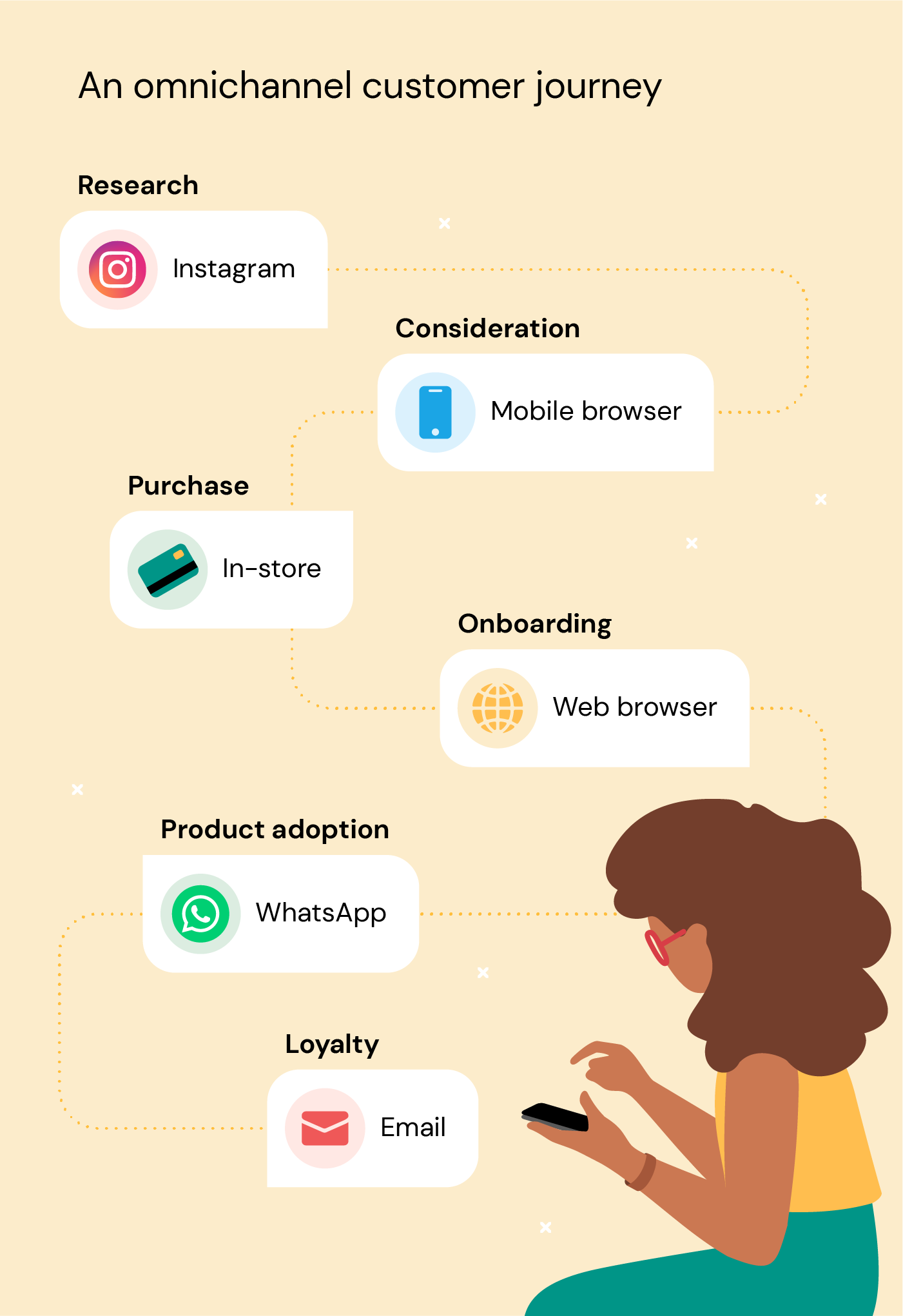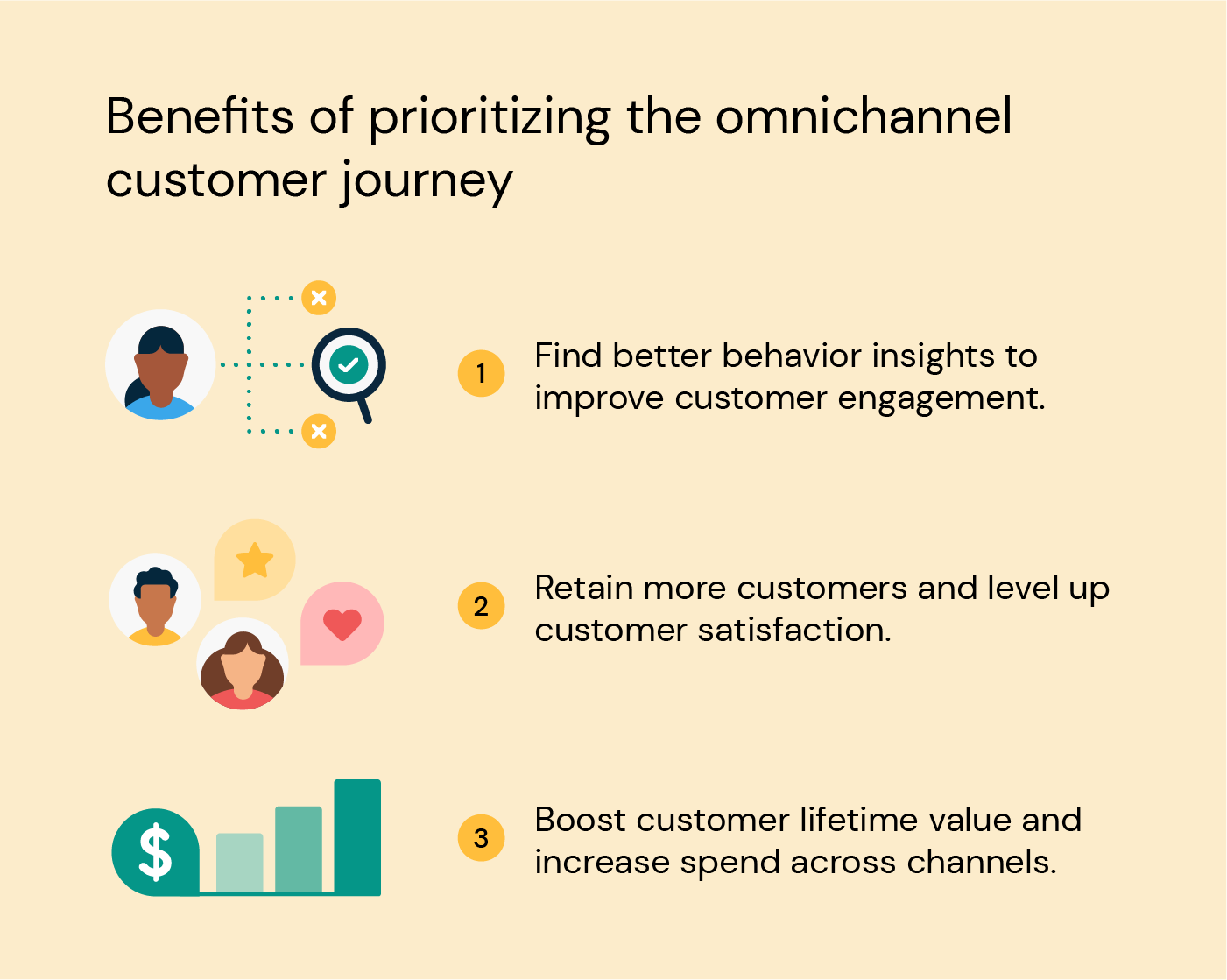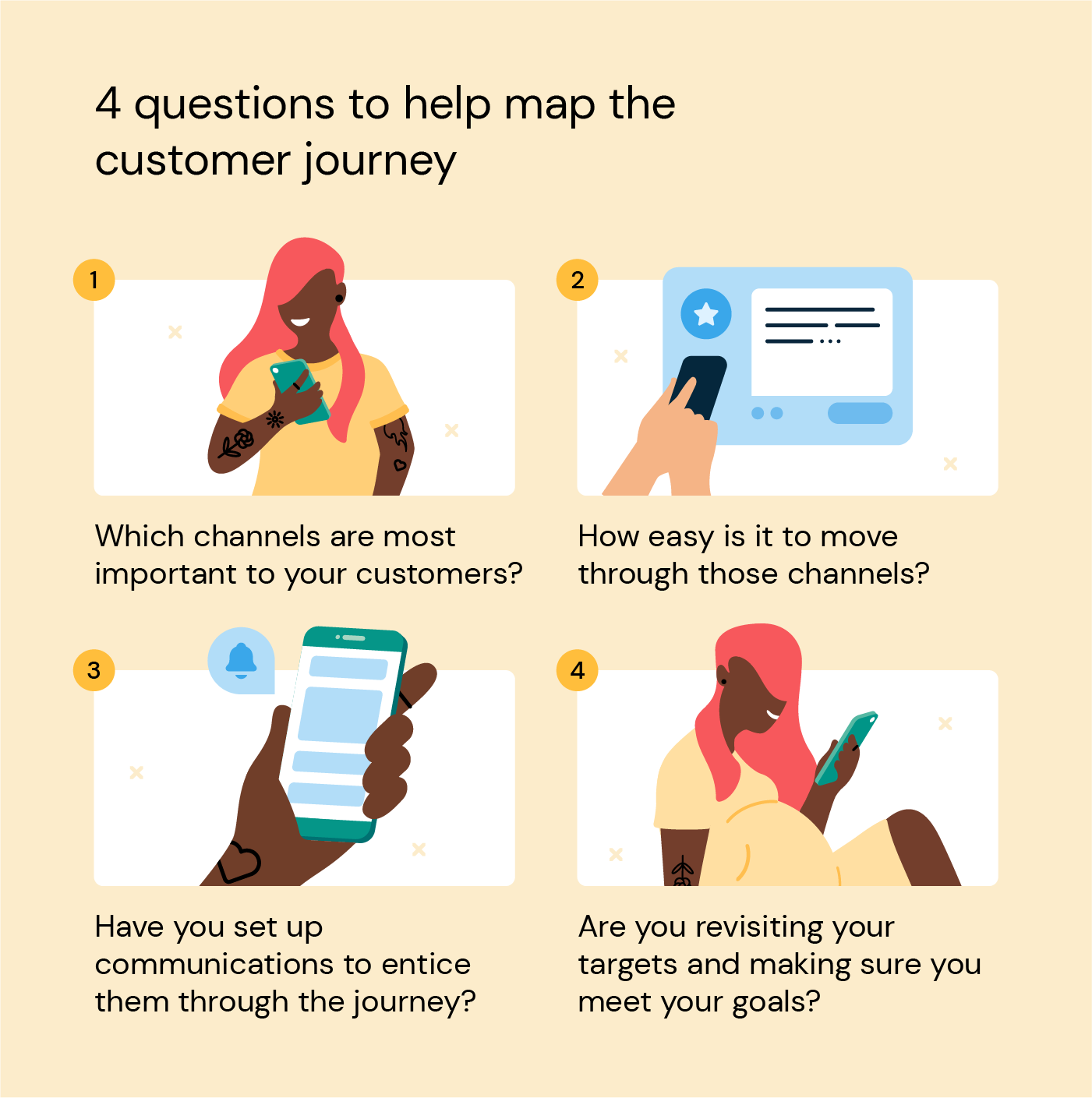When someone moves through an omnichannel customer journey with a brand, they’ll use many channels. They might receive a marketing email and then a text message for a reminder or a confirmation. They might engage with customer service via voice, video, or chat. They might even interact with chatbot or voice bot.
The ideal omnichannel customer journey is a seamless, connected customer experience. If your goal is a customer-centric strategy, reaching people on all the channels they use in their journey with your brand is a great place to start.
We’ll map the step-by-step journey that’ll take your business from zero to omnichannel hero and help you build unforgettable customer experiences.
6 steps in the omnichannel customer journey

Every customer buying journey is unique. When people come to your brand, it’s up to you to meet their expectations in their channel of choice. Here’s a look at a customer’s typical purchasing journey and how an omnichannel approach can help them every step of the way.
1. Researching and consuming content
From the outset, the customer starts looking for solutions, using search engines to find and gather helpful info from experts and thought leaders.
With phones never far from reach, mobile engagement is crucial to capturing new customers in their exploratory phase - and locking in their interest.
2. Considering and comparing
Before deciding, the customer weighs their options and debates which brands to trust. While they’re taking in information about your brand and offerings, it’s a critical time to present a solution.
For example, 92% of people that Sinch surveyed said they want a chatbot feature to help identify the in-store availability of a product they’re researching online. You can also offer a coupon for that item to entice them.
3. Purchasing
It’s decision time. The customer gives something up (time, money, etc.) to solve their problem and get what they need.
Whether they make a final purchase in a physical location, on the web, or in a rich message through a social channel, this phase should offer a standout, convenient experience that meets the customer in the moment of need.
4. Onboarding
Finally, the customer has their solution. Now they need to learn how to use the tool to solve their problem, or they might abandon the journey for a different path.
By offering support features like chatbots and live assistants, you can make sure customers are supported throughout the purchasing experience and set them up with clear expectations for what will come next.
5. Adopting the product
Once you’ve successfully onboarded, it’s time for the customer to get used to the product and adopt it for themselves - this is where checking in is key.
Gather customer feedback and continually improve CX by creating opportunities for simple future interactions (and even future purchases).
6. Returning with loyalty
The satisfied customer goes back to their everyday life with a positive story to share with others. One easy way to naturally build loyalty is by showcasing examples of customer success during the purchase process.
If you have case studies or customer stories, share them with new and prospective customers. Keep communication regular, checking in for support opportunities and chances to adopt new customers into the fold.
3 reasons why your business should focus on the customer journey

The reality is that the more work you put into mapping your journey and making it as frictionless as possible, the more rewards you’ll reap. Here are the three top benefits of focusing on an omnichannel customer journey.
1. Better customer behavior insights
With an omnichannel strategy, a customer journey map gives you an overview of customer behavior and insights that can help improve your business.
Take Nissan, for example. By leveraging CRM and personal mobile messaging campaigns for more detailed insights, they boosted engagement by nearly 500%!
2. Higher customer retention
By focusing on the journey and highlighting areas of improvement, your business can create a unique, engaging CX that increases satisfaction and boosts retention.
Customers crave authentic conversations - they build up loyalty that keeps them coming back again and again.
3. Boosted customer value
Omnichannel customers are more valuable to businesses - they’re likely to spend 10% more online versus customers restricted to just one channel. When you look at customers who receive rich multimedia mobile messaging and personalized content, it’s clear that real added customer value is easy to achieve and manage.
Mapping a frictionless customer journey

The journey depends on the channels customers use. A true omnichannel journey has a frictionless shift from channel to channel, creating a familiar experience where you’re not in the dark about your customers’ needs.
1. Identify channels
Part of an omnichannel strategy is determining customer preference. Each step should be convenient for customers - not just your business - so aim to connect with people on the platforms they use daily. For example, in-message replies are important to 90% of customers, so two-way chat is crucial in your omnichannel strategy.
Sinch can help your business synthesize customer data to identify your most valuable touchpoints.
2. Lay out the journey
Now that you’ve identified the most important touchpoints for your customers, you need to develop a strategy and meet them there.
Consider mapping with a flowchart to visualize the journey for yourself and pinpoint places where communication will be key in moving the journey forward. Do you experience lots of cart abandonment? Finding trouble spots can help you quickly address them and implement changes - this is when mapping becomes managing the journey.
3. Strategize communications
Communication is critical to keeping valuable omnichannel customers. For disengaged customers who don’t often use your app, you might need to draw them in with a lucrative marketing offer. Highly engaged customers will seek out their own communication path on their preferred channel.
With Sinch, you can manage cross-channel communication that provides more value to users where they expect it.
4. Connect your targets to your goals
To fully capitalize on the knowledge from a connected customer journey, you should connect your journey’s targets and goals. Some questions that help connect those dots include:
- What metrics are most important to your omnichannel strategy?
- Do you know your ROI on each channel?
- What’s your customer's lifetime value?
- Can you map customer satisfaction over time, and is it improving?
This connection point isn’t a one-and-done deal. Revisit these questions as often as possible - at least quarterly - to assess growth and spot trouble areas early on. For example, if customer satisfaction is decreasing - you might need to return to the mapping phase and rediscover which channels are most important to your base.
Customer journey use cases
Customer journeys can be overwhelming. At Sinch, we’re all about keeping things simple. We get that sometimes it’s easier to connect "techy things" to reality for a better picture of their impact on someone’s life. Keep reading for a real-world example of how an omnichannel approach can make a difference.
The customers:
- Thirty-two-year-old Ryan Patel works in corporate IT and is very tech-savvy. He always has his phone and researches nearly every purchase he makes.
- Twenty-nine-year-old Angie Patel is pregnant and plans to work until a week before her due date. She needs help keeping track of all the appointments leading up to the big day. Angie is an active social media user and posts on Instagram daily. She’ll document her new parent journey and find trendy baby products on the channel.
The brands:
- Athena Women’s Care Clinic: This regional healthcare provider specializes in serving women throughout their pregnancy. It uses groundbreaking treatments, cutting-edge technology, and a human touch to give expectant mothers all the care and attention they need.
- Bambino baby products: Millennial parents love this brand’s stylish, sustainable options and its exceptional e-commerce experience. This brand will act as an ally that provides tools for reliable customer service.
Let’s dive in and learn how these two brands use omnichannel customer support to help this young couple navigate a massive life change. We’ll use the steps of a customer’s journey to call out omnichannel touchpoints as we go. If you'd like to download the e-book and read the full story later, get your free copy here:

Touchpoint #1: Email marketing automation
Ryan and Angie sign up with Athena Women’s Care and get a welcome email congratulating and encouraging them. Because they filled out a form on sign-up, all the emails in the series that follow are personalized and help guide the couple on what to expect as first-time parents.
The right message delivered at the right time helps calm the Patels’ worries about being first-time parents. It also convinces them that Athena Women’s Care Clinic is a provider they like and trust.
The first step on their healthcare journey is an appointment with Angie’s obstetrician.
Touchpoint #2: Appointment confirmations and reminders
Ryan and Angie opt for appointment confirmations and reminders over MMS when they set up their account with Athena. These multimedia reminders prove helpful in balancing busy schedules with the demands of pregnancy. Plus, they never miss an appointment and can reschedule if needed. Opting out is always an option if it gets too much, though.
Athena Women’s Care offers a birth coaching service for new moms who want extra support. Angie’s birth coach works from home three days a week, so some sessions will be virtual.
Touchpoint #3: Telehealth video calls
Athena has in-app video calling so doctors and specialists can meet patients as safely as possible. It’s a popular way to meet because it fits into busy schedules, reduces costs, and cuts down on no-shows. All Angie has to do is log in to the app and click a button to start the appointment.
After their first doctor's appointment, the Patels crossed the threshold into the universe of expectant parents. It’s a whole new world where they’ll make several purchases. Angie and Ryan discover the brand Bambino via an Instagram influencer. They both love Bambino’s trendy baby furniture. Angie follows them on social media, and the Patels start shopping.
Touchpoint #4: Conversational selling
It's not long before Angie has questions, so she messages Bambino on Instagram about a crib she likes. She then places her first order via Instagram, thanks to conversational commerce.
Angie has a positive conversation with the brand via a chatbot. The conversational AI helps with customization, answers her questions, and even cracks a joke. Angie buys some sheets and a changing table that matches the crib.
With boxes now arriving at their door, Ryan wants to stay organized, so he tracks everything and checks them off the list.
Touchpoint #5: Order confirmations and shipping updates
Every time the Patels buy something online, they get a message or an email to confirm. These messages act as receipts and provide helpful tracking information. Ryan also uses SMS to reschedule a few deliveries.
Some order tracking emails include real-time shipping updates; others ask for satisfaction ratings or reviews.
Sometimes, brands will bring challenges. In fact, customer frustration is the perfect chance for brands to ally with a rock-solid omnichannel customer experience.
For example, after ordering a car seat from Bambino, Angie and Ryan decide to install it months before the new arrival. The directions confuse Ryan, and he wants to install the car seat safely.
Touchpoint #6: Customer service chats
First, Ryan contacts the Bambino chatbot on WhatsApp for help. But he’s still confused, so the bot transfers him to a live support agent.
Now, Ryan can have a two-way conversation with a human being; he can send pictures and get help. The Bambino agent already has Ryan’s purchase history and can see the chatbot conversation because it’s all integrated into a CPaaS platform. No time gets wasted repeating product numbers and other basic info.
Angie also has a lot of questions about her health throughout the pregnancy. She’s uncomfortable with random internet advice so she goes to her healthcare provider. Helpful content gets delivered in personalized emails from Athena Women’s Care, but there are times when she needs specific answers right away.
Touchpoint #7: FAQ and beyond
Athena Women’s Care has a chatbot to answer common pregnancy questions. They found it helps cut call volume while still giving patients trustworthy and timely information.
Angie learns the answers to her pressing questions; if she’d had a more complex question, the AI in the chatbot knows when it’s time to transfer her to a live healthcare professional for help.
If that happens, the healthcare professional she speaks to can access Angie’s conversation with the chatbot. Patients can also contact a toll-free, 24-hour nurse hotline when tough questions and urgent situations arise. Angie can even text the same toll-free number if she has follow-up questions.
However, Angie can’t remember her password for the online account with Athena Women’s Care.
Touchpoint #8: Password resets and verifications
Angie requests a password reset in the app and can choose to get a one-time passcode via SMS or a flash call on her Android smartphone to verify her identity. With the former, she’ll have to enter it into the app manually, and with the latter, a quick call to her phone will allow her to get access seamlessly.
Not only is the experience painless, but it also builds trust in the brand. Angie knows that Athena is protecting her sensitive health information with two-factor authentication.
There’s a twist during the Patels’ ultrasound appointment - they plan to find out the sex of their baby, but instead, discover they’re having twins. The news overwhelms them. Having twins amplifies all their expectations about the journey.
Touchpoint #9: Email nurturing
Once Athena Women’s Care gets the update about Angie’s pregnancy, they include the Patels in a new tailored subscribers segment. Now, the Patels get personalized emails on giving birth to twins. It also connects them to a local parent support network for parents of multiples.
Of course, the Patels will need to do more online shopping now. Some of their new baby products, like the stroller, won’t work with twins.
Touchpoint #10: Returns, exchanges, and repeat purchases
Ryan goes to his email inbox to find and print return labels for products still in boxes. For things he’s already put together, Ryan finds the order confirmation email, clicks on the embedded “click to WhatsApp” button, and starts a conversation with a customer service representative at Bambino via WhatsApp.
Angie prefers SMS for customer communications, and with an omnichannel strategy, that can also be a rich experience. RCS (rich communication services) brings an app-like feel to text messaging. Angie can browse different colors and designs for baby products she’s already purchased – because now she needs two of everything.
Leading up to the birth of the twins, the Patels decide to schedule a delivery date and have Angie induced rather than waiting for labor to start naturally. Here’s another opportunity for omnichannel communication to make a difference.
Touchpoint #11: The final communications
The couple meets with Angie’s doctor and birth coach on a video call to discuss the birth plan. They discuss everything from pain medication to the lighting in the room during delivery. Because this call happens on the clinic’s platform, sensitive medical information is 100% protected.
Since the Patels have a scheduled delivery, Athena Women’s Care sends a few reminders ahead of the big day. Encouraging emails and text messages highlight personal items Angie might need during her hospital stay and help boost her confidence.
Create better customer experience strategies with the right omnichannel tools
Every customer journey has a beginning - do you know where yours is?
Download the full Omnichannel Hero’s Journey PDF completely free (we won’t even ask for your email address!) to find out more about creating better marketing strategies, plus more insights on:
- Building a top-class customer journey
- Using a B2B omnichannel strategy
- Boosting the customer experience
- Starting out with omnichannel communication

Looking into CPaaS providers? Wondering which vendors are best positioned to support your present and future communications use cases and what you should consider when choosing a CPaaS solution?
Get a copy of the 2023 Gartner® Magic Quadrant™ for Communications Platform as a Service (CPaaS) to find out.




